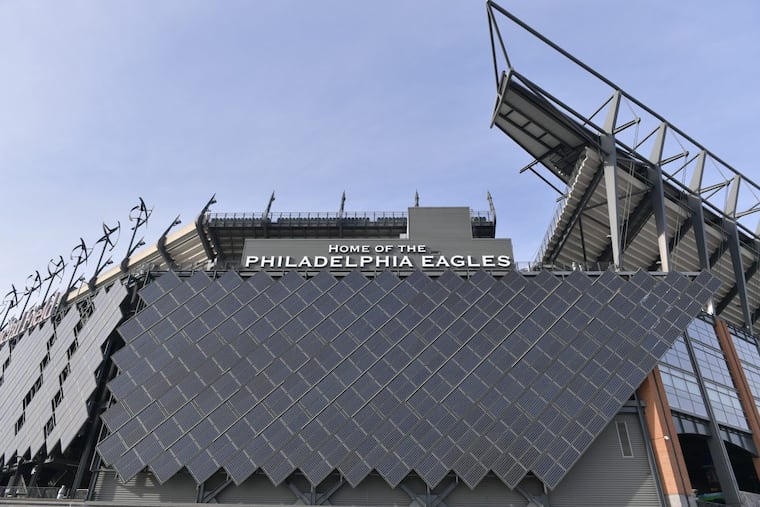Green smackdown: Lincoln Financial Field vs. U.S. Bank Stadium
The Linc was widely recognized for being at the forefront of that and was recently cited by the Department of Energy as one of the top NFL stadiums in efficiency. Yet, even newer venues such as the $1.1 billion U.S. Bank Stadium are popping up with environmental friendliness at the forefront.

Philadelphia's Lincoln Financial Field opened in 2003, designed as an open-air maw under churning, talon-shaped wind turbines and filled with fans cheering, foggy-breathed in the cold.
U.S. Bank Stadium, where the Eagles will play Sunday in Minneapolis, is cushy with its translucent polymer roof and 72-degree indoor temperature and fireplaces all set in what's described as an architectural bauble.
The Linc is literally green when filled with 69,000 fans. But how do the stadiums compare when it comes to the other green, the environment?
Both stadiums came online after big cities started getting serious about cutting energy use and waste, just as demand for new sports venues was exploding. No longer did fans want concrete-laden, multisport municipal stadiums. In both cities, that meant two stadiums where one once served — and therefore more energy use.
Lincoln Financial Field was widely recognized for being at the green forefront and cited by the U.S. Department of Energy as one of the top NFL stadiums in energy efficiency. Yet, newer venues such as the $1.1 billion U.S. Bank Stadium are designed with even more up-to-date environmental features and materials.
Both Philadelphia and Minneapolis require building owners to report yearly total power use. U.S. Bank Stadium didn't open until 2016, and its data for 2017 are not yet available, so it's difficult to compare the two stadiums.
"Even if you did have total power usage, you can't do a fair comparison," says Alex Dews, executive director of Green Building United . "One is an indoor facility, and one is a lot of lights shining on a field."
Football isn't always fair. So here's our environmental play-by-play:
On-site renewable energy
One-third of all NFL teams play or train at facilities with on-site solar, but Lincoln Financial Field has the biggest array. The Indianapolis Motor Speedway is the only other sports venue that tops it.
The Linc has 11,108 solar panels on its sides, parking lot's roofed areas, and street. It has 14 micro-wind turbines. The full installation is part of a partnership with the retail energy provider NRG to deliver power to the structure's 166,611 square feet of enclosed space and other uses.
The system supplies 3 megawatts of power — a third of yearly needs. The Solar Energy Industries Association calculates that 3 megawatts of solar can power 345 Pennsylvania homes, or 37,000 32-inch LED TVs during the Super Bowl.
On nongame days, the system produces more than is used by office operations. Excess electricity flows back to the grid. The remainder of what's needed for the year is purchased from renewable energy sources. So the Linc can claim it is powered by 100 percent renewable energy.
NRG also has a partnership to heat and cool U.S. Bank Stadium's massive 1.75 million-square-foot structure. But it couldn't reasonably do that with solar.
So, the company taps into chilled water and steam plants located around Minneapolis and pipes water to the stadium for heating and cooling. NRG says this is efficient because the building doesn't have to operate a separate system.
Winner: Lincoln Financial Field.
Lighting
Lighting is a huge cost in stadiums, especially during night games. LED lighting consumes 75 percent less electricity than traditional halide stadium lighting and lasts longer. That's why U.S. Bank Stadium, the first NFL stadium to have LED installed from the ground up, has a big advantage. The LEDs can also be adjusted according to the amount of light flowing in through its translucent roof.
The Linc was built without the more modern lighting system but was able to save up to five years in electric costs after installing new occupancy-based lighting controls.
Winner: U.S. Bank Stadium
Mass-transit access
SEPTA's Broad Street Line serves Lincoln Financial Field with its AT&T Station stop at Broad and Pattison — about one-quarter mile from the Linc's gates.
Andrew Bush, a SEPTA spokesman, said the trains deliver 12,000 to 15,000 passengers for regular-season games. Ridership spiked to 29,000 for the NFC championship game vs. Minnesota. The Linc holds 69,000.
At U.S. Bank Stadium, Metro Transit light-rail lines drop passengers right outside the doors. Howie Padilla, a spokesman for Metro, said about 20 percent of fans, or about 13,200, take the train to the 66,000-capacity stadium.
U.S. Bank also gets points for easier access for bicycles, with 180 racks, as well as other forms of transportation.
Winner: Tie
Waste
At the Linc, about 99 percent of waste is diverted away from landfills. Among other innovations, it has a large Eco-Safe Digester – or "bio-digester" – by BioHiTechGlobal that can process up to 2,400 pounds of food scraps daily.
U.S. Bank Stadium was built with the goal of becoming a zero-waste facility, meaning that almost all waste is recycled or composted. It generated 1,000 tons of waste in its first year — roughly the weight of nine million hot dogs. It is shooting for 90 percent diversion.
Winner: Tie
Green ratings
U.S. Bank has a gold LEED rating and scored 60 out of 110 in sustainability, water efficiency, energy use, material, indoor environment, and innovation. LEED, or Leadership in Energy and Environmental Design, is a green-building rating system.
It scored so high because it was built with the newest materials and has easy connectivity to the city.
Lincoln Financial Field was awarded a silver rating in 2013 just as new solar was being installed. So it's not clear whether newer upgrades are included in the score. In addition, the Linc is judged differently because it is older construction.
Winner: U.S. Bank Stadium